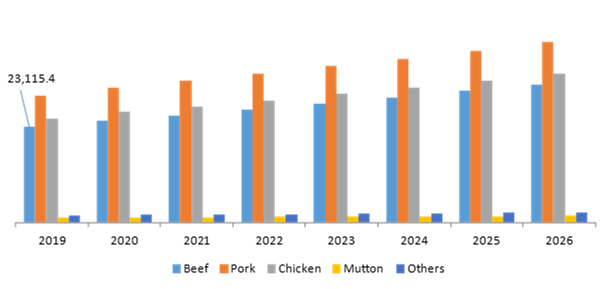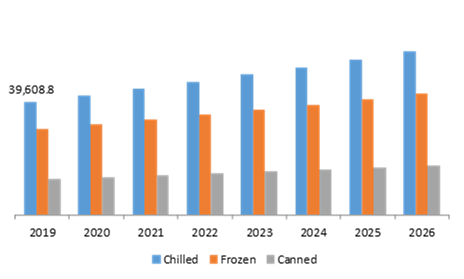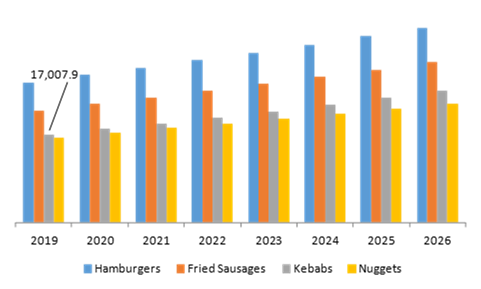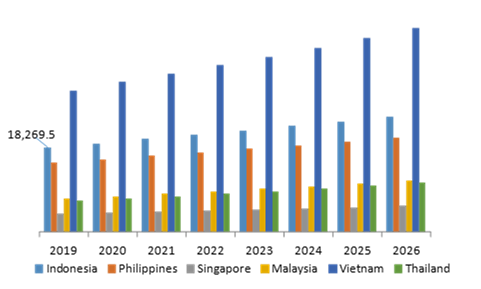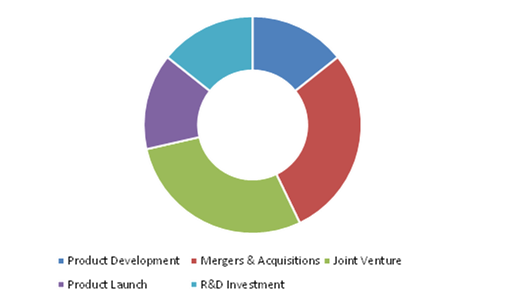The Southeast Asia Meat Product Market Report
RA00408
The Southeast Asia Meat Product Market, by Type (Beef, Pork, Chicken, Mutton, and other), Packaging (Chilled, Frozen, and Canned), Processed Meat Type (Hamburgers, Fried Sausages, Kebab, and Nuggets), Regional Analysis (Malaysia, Thailand, Singapore, Vietnam, Indonesia, and the Philippines): Opportunity Analysis and Industry Forecast, 2019–2026
The Southeast Asia meat product market forecast shall be $1,17,259.2 million by 2026, increasing from $82,182.5 million in 2019, at a healthy rate of 5.1%. Thailand’s meat product market is estimated to increase at a CAGR of 6.5% by registering revenue of $10,693.1 million throughout the analysis period. An increase in income of the population and urbanization, along with the availability of online platforms for ready-to-eat meat products, processed meat products, and chilled meats, are expected to accelerate the southeast asia meat product market growth.
Southeast Asia Meat Product Market Analysis:
The Southeast Asia meat production business mainly deals with a broad range of products such as beef, mutton, chicken, pork, and other animal derivatives. The rising incomes, extensively increasing population, and growing urbanization has contributed to the growth in meat consumption and livestock production in the SEA countries.
Impact Analysis of COVID-19 on the Southeast Asia Meat Product Market:
The COVID-19 pandemic crippled almost every industry in the SEA region. The most affected processes of every industry are production, supply chain, transportation, product manufacturing, and other activities. Furthermore, the pandemic has created an immense impact on southeast asia meat product market.
On the other hand, the governments of Southeast Asian countries are supporting food industries to overcome the loss. For instance, Thailand’s Ministry of Commerce, on 6th April 2020, announced that they have set up 7 joint rooms for relevant working between industries and government to ensure a sufficient supply of necessities including meat. Also, according to the National Report of Thailand published in May 2020, Thailand is planning to boost up their chicken meat exports by 10% this year to raise the level of self-sufficiency in local meat production. These initiatives may offer huge opportunities for the southeast asia meat product market, in the midst of the COVID-19 pandemic.
The enormously increasing popularity for ready-to-eat meat products, frozen meat products, and others may flourish the Southeast Asia meat product market
The meat market is witnessing massive growth mainly because of the emerging technology which influenced the high standard of living and urbanization in the Southeast Asia region. Ready to eat products, frozen products, and processed meat products are on higher demand owing to the availability of these products at affordable prices. Also, to maintain and fulfill all the requirements of customers, leading meat manufacturers such as Charoen Pokphand Foods PCL, Angliss Singapore Pte Ltd have integrated their products with instant foods and smart packaging. These factors may create a significant impact on the SEA meat product market. Moreover, several meat products such as spring Meat, summer meats, autumn meats, and winter meats are available only in a specific season. Thus, to fulfill the demand, manufacturers are focusing on freezing meat products to preserve them for a longer time and make them available in all seasons. These advancements may lead to an increase in the demand for meat production in the global market.
To know more about Southeast Asia Meat Product Market drivers, get in touch with our analysts here.
An upsurge in vegetarianism may restrain the growth of the Southeast Asia meat product industry
The notable growth in the number of vegans in Southeast Asia countries, particularly in Malaysia, Singapore, and Thailand, may obstruct the growth of the global meat market. Moreover, post pandemic hatred towards certain animal meat with fear of having other contagious diseases is another aspect affecting the meat market and it may also create a negative impact on the Southeast Asia meat product market, during the forecast period.
The growing prominence of modern technologies such as meat culture may create huge opportunities for the southeast meat product market in the future
The meat industry is growing at a very fast pace due to the rise in the urban population and an increase in incomes in Southeast Asian countries. Moreover, the growth in newly emerging technologies like meat culture are expected to provide lucrative market opportunities for the production of meat artificially. Emerging players operating in the market are planning to commercialize the-lab meat products in the upcoming years. Also, to offer more effective products to their customers in the future, meat researchers are looking forward to decreasing the cost of lab-grown meats or clean meats, which will help in attracting consumers towards new technology and exhibit concentration on developing new business models and strategies. For instance, Future Meat, a notable player in cultured-meat products, is planning to produce cost-efficient and genetically modified meat directly from the animal stem cells without the need to harvest animals. These key factors and ongoing researches may generate investment opportunities for the meat industry in the Southeast Asia meat products market.
To know more about Southeast Asia Meat Product Market Opportunities, get in touch with our analysts here.
Southeast Asia Meat Product Market, by Meat Type:
The beef meat type will generate a revenue of $33,382.5 million by 2026, owning to the growing awareness about beef as a significant source of protein
Source: Research Dive Analysis
Beef meat type shall have the fastest market growth in the Southeast Asia meat product market and is expected to register a revenue of $33,382.5 million, during the analysis timeframe. Beef products are mostly referred in Southeast Asian countries as traditional cuisine. The extensively surging demand for beef products in the Southeast Asia region is majorly attributed to the increasing popularity of innovative beef products like chilled beef, canned corned beef, growing awareness about beef as a crucial source of protein, and rising disposable income.
On the other hand, the Southeast Asia pork meat market accounted for the highest market value in the year 2019 with a value of $30,775.7 million and is projected to reach $43,636.9 million by the end of forecast period. The growth of the pork sub-segment for the southeast asia meat product market is mainly influenced by the higher demand for pork meat for many practical and historical reasons. In addition, changing consumer preferences coupled with the availability of popular brands including CP-Kurobuta Pork Ham, CP-Kurobuta Fresh Pork Ham, Hygienic Minced Pork, and Hygienic Pork Loin Slices influence the pork meat demand. These key factors are expected to boost the demand for pork meat in the Southeast Asia market during the projected period.
Southeast asia meat product market , by Packaging:
The chilled packaging meat sub-segment will have the highest market share; this is mainly because of the the growing demand for the richer and diverse diet
Source: Research Dive Analysis
The chilled meat packaging sub-segment will have the fastest market growth and it is projected to surpass $57,360.5 million by 2026, with an increase from $ 39,608.8 million in 2019; this is mainly because of the steady demand for foods that are ready-to-eat and in chilled form for longer shelf life. Moreover, rising health concerns coupled with the extensive demand for diverse nutrient diet is expected to generate a huge demand for chilled packaging type, which will ultimately spur the growth of the Southeast Asia meat product market, throughout the forecast period.
Southeast Asia Meat Product Market, by Processed Meat Type:
Kebabs will have significant-growth in the global market; this is mainly because of the rising demand for ready to eat meat products
Source: Research Dive Analysis
Kabab is the fastest-growing sub-segment and is estimated to reach $25,437.2 million by 2026, at a CAGR of 5.8%, increasing from $17,007.9 million in 2019. Kebab is recognized as one of the most popular food products with superior taste across the SEA region. Thus, the SEA-based companies involved with kebab businesses are adopting multiple strategic steps to stronghold their presence in the global market. For example, in February 2019, PT BABA RAFI ENTERPRISE, Indonesia-based world's largest chain of kebab stores, teamed up with India-based entrepreneurs to expand meat products in India. Also, this company has a prominent presence in Malaysia, Singapore, Vietnam, and other countries, across the world. Such business expansions may further lead to remarkable market opportunities in the SEA market.
On the other hand, the hamburgers sub-segment shall have rapid growth and it is anticipated to generate a revenue of $37,660.3 million by 2026, during the forecast period. Hamburgers are a type of processed meat that is on higher demand nowadays. Moreover, efficiency in production, the fast-paced life, and the development of multiple franchises are some of the key factors of the segment that will accelerate the market growth, during the review period, in the Southeast Asia region.
Regional Insights:
The Thailad region has a lucrative meat market and it will reach up to $10,693.1 million by the end of 2026 mainly because of the implementation of effective policies from the government
Source: Research Dive Analysis
Thailand’s meat product market share is projected to grow at a CAGR of 6.5% by registering a revenue of $10,693.1 million by 2026. The extensive growth of the Thailand meat product market is significantly attributed to the strict animal disease & food safety control, enhancement in farm productivity, and the sophisticated development of end-products in Southeast Asian countries. Such key factors are expected to propel the growth of the market, over the forecast period.
The Vietnam meat market accounted for $30,671.7 million in 2019 and is projected to register a revenue of $44,155.2 million by 2026. The extensive growth of the Vietnam meat market is mainly driven by key factors such as heavy investments by market players for the production of innovative meat products. In addition to this, the country’s surging population, changing cultural preferences, and new trade agreements have opened up the door to massive growth in the Vietnam meat product market, across the SEA region.
Competitive Scenario in the Southeast asia meat product market :
The advanced product development coupled with mergers & acquisitions are the frequent strategies followed by the significant market players
Source: Research Dive Analysis
Some of the leading meat market players include Charoen Pokphand Foods PCL., Angliss Singapore Pte Ltd., Bangi Argo Malaysia., BETAGRO PUBLIC COMPANY LIMITED, GFPT Public Company Limited., Thai-German Meat Product Company Limited, Saha Farms Co. Ltd, Centaco, F & G Food Pte Ltd, and Chop Hup Chong Food Industries Pte Ltd. Meat market players are focusing on Merger & acquisition and advanced product developments. These are the effective strategies followed by the startup as well as established organizations.
Porter’s Five Forces Analysis for Southeast Asia Meat Product Market:
- Bargaining Power of Suppliers: The meat suppliers are low in number, as most of the Southeast asia meat product market companies have their own livestock farm. So, there will be low bargaining power to the suppliers. Thus, the bargaining power of the supplier is Moderate
- Bargaining Power of Buyer: Buyers will have high bargaining power, significantly because of multiple players operating in the Southeast asia meat product market . The Meat market vendors offers innovative meat product with longer expiry at reasonable price rate. The buyers can freely choose the convenient product that best fits their preferences. Thus, the bargaining power of the buyer is HIGH
- Threat of New Entrants: The companies entering into the southeast asia meat product market are adopting technological innovations such as artificial intelligence for food safety to attract the customers. Also, these companies are implementing various effective strategies such as eco-friendly packaging or antimicrobial packaging and many among others. Thus, the bargaining power of the new entrant is Moderate
- Threat of Substitutes: Customer preference and several substitutes are available in this market such as cultured meat or Plant based meats. However, such alternative options are not commercialized and many people find it unethical to produce animal in the lab. Thus, the threat of substitute is Low
- Competitive Rivalry in the Market: The competitive rivalry among the meat industry leaders is rather intense, especially between the global players including GFPT Public Company Limited. and Thai-German Meat Product Company Limited. These companies are launching high value meat products in the international market and strengthening the footprint worldwide.
Competitive Rivalry in the meat Market: High
| Aspect | Particulars |
| Historical Market Estimations | 2018-2019 |
| Base Year for Market Estimation | 2019 |
| Forecast timeline for Market Projection | 2020-2026 |
| Geographical Scope | North America, Europe, Asia-Pacific, LAMEA |
| Segmentation by Meat type |
|
| Segmentation by Packaging |
|
| Segmentation by Processed Meat Type |
|
| Key Companies Profiled | • Charoen Pokphand Foods PCL. • Angliss Singapore Pte Ltd. • Bangi Agro Malaysia. • BETAGRO PUBLIC COMPANY LIMITED • GFPT Public Company Limited., • Thai-German Meat Product Company Limited • Saha Farms Co. Ltd • Centaco • F & G Food Pte Ltd • Chop Hup Chong Food Industries Pte Ltd. |
Q1. What is the size of the Southeast Asia meat product market?
A. The Southeast Asia meat product market size was over $ 82,182.5 million in 2019 and is projected to reach $ 1,17,259.2 million by 2026.
Q2. Which are the major companies in the Southeast Asia meat product market?
A. Charoen Pokphand Foods PCL and Angliss Singapore Pte Ltd. are some of the key players in the Southeast asia meat product market.
Q3. Which region possesses greater investment opportunities in the coming future?
A. The Thailand region possesses great investment opportunities for the investors to witness the most promising growth in the future.
Q4. What is the growth rate of the Thailand ?
A. Thailand Meat market is anticipated to grow at 6.5% CAGR during the forecast period.
Q5. What are the strategies opted by the leading players in this market?
A. Capacity expansion, product development, along with joint ventures are the key strategies opted by the operating companies in this market.
Q6. Which companies are investing more on R&D practices?
A. Charoen Pokphand Foods Pcl, Angliss Singapore Pte Ltd companies are investing more on R&D activities for developing new products and technologies.
1. Research Methodology
1.1. Desk Research
1.2. Real time insights and validation
1.3. Forecast model
1.4. Assumptions and forecast parameters
1.4.1. Assumptions
1.4.2. Forecast parameters
1.5. Data sources
1.5.1. Primary
1.5.2. Secondary
2. Executive Summary
2.1. 360° summary
2.2. By Meat Type trends
2.3. By Packaging trends
2.4. By Processed Meat Type trends
3. Market Overview
3.1. Market segmentation & definitions
3.2. Key takeaways
3.2.1. Top investment pockets
3.2.2. Top winning strategies
3.3. Porter’s five forces analysis
3.3.1. Bargaining power of consumers
3.3.2. Bargaining power of suppliers
3.3.3. Threat of new entrants
3.3.4. Threat of substitutes
3.3.5. Competitive rivalry in the market
3.4. Market dynamics
3.4.1. Drivers
3.4.2. Restraints
3.4.3. Opportunities
3.5. Technology landscape
3.6. Regulatory landscape
3.7. Patent landscape
3.8. Pricing overview
3.8.1. By Meat Type
3.8.2. By Packaging Type
3.8.3. By Processing Meat Type
3.9. Market value chain analysis
3.9.1. Stress point analysis
3.9.2. Raw material analysis
3.9.3. Manufacturing process
3.9.4. Distribution channel analysis
3.9.5. Operating vendors
3.9.5.1. Raw material suppliers
3.9.5.2. Product manufacturers
3.9.5.3. Product distributors
3.10. Strategic overview
4. Southeast Asia Meat Market, by Meat Type
4.1. Beef
4.1.1. Market size and forecast, by region, 2020-2026
4.1.2. Comparative market share analysis, 2020-2026
4.2. Pork
4.2.1. Market size and forecast, by region, 2020-2026
4.2.2. Comparative market share analysis, 2020-2026
4.3. Chicken
4.3.1. Market size and forecast, by region, 2020-2026
4.3.2. Comparative market share analysis, 2020-2026
4.4. Mutton
4.4.1. Market size and forecast, by region, 2020-2026
4.4.2. Comparative market share analysis, 2020-2026
4.5. Others
4.5.1. Market size and forecast, by region, 2020-2026
4.5.2. Comparative market share analysis, 2020-2026
5. Southeast Asia Meat Market, by Packaging
5.1. Chilled
5.1.1. Market size and forecast, by region, 2020-2026
5.1.2. Comparative market share analysis, 2020-2026
5.2. Frozen
5.2.1. Market size and forecast, by region, 2020-2026
5.2.2. Comparative market share analysis, 2020-2026
5.3. Canned
5.3.1. Market size and forecast, by region, 2020-2026
5.3.2. Comparative market share analysis, 2020-2026
6. Southeast Asia Meat Market, by Processed Meat Type
6.1. Hamburgers
6.1.1. Market size and forecast, by region, 2020-2026
6.1.2. Comparative market share analysis, 2020-2026
6.2. Fried Sausages
6.2.1. Market size and forecast, by region, 2020-2026
6.2.2. Comparative market share analysis, 2020-2026
6.3. Kebab
6.3.1. Market size and forecast, by region, 2020-2026
6.3.2. Comparative market share analysis, 2020-2026
6.4. Nuggets
6.4.1. Market size and forecast, by region, 2020-2026
6.4.2. Comparative market share analysis, 2020-2026
7. Southeast Asia Meat Market, by Country
7.1. Indonesia
7.1.1. Market size and forecast, by meat type, 2020-2026
7.1.2. Market size and forecast, by packaging, 2020-2026
7.1.3. Market size and forecast, by Processing meat type, 2020-2026
7.1.4. Market size and forecast, by country, 2020-2026
7.1.5. Comparative market share analysis, 2020-2026
7.2. Malaysia
7.2.1.1. Market size and forecast, by meat type, 2020-2026
7.2.1.2. Market size and forecast, by packaging, 2020-2026
7.2.1.3. Market size and forecast, by Processing meat type, 2020-2026
7.2.1.4. Comparative market share analysis, 2020-2026
7.3. Thailand
7.3.1.1. Market size and forecast, by meat type, 2020-2026
7.3.1.2. Market size and forecast, by packaging, 2020-2026
7.3.1.3. Market size and forecast, by Processing meat type, 2020-2026
7.3.1.4. Comparative market share analysis, 2020-2026
7.4. Singapore
7.4.1.1. Market size and forecast, by meat type, 2020-2026
7.4.1.2. Market size and forecast, by packaging, 2020-2026
7.4.1.3. Market size and forecast, by Processing meat type, 2020-2026
7.4.1.4. Comparative market share analysis, 2020-2026
7.5. Vietnam
7.5.1. Market size and forecast, by meat type, 2020-2026
7.5.2. Market size and forecast, by packaging, 2020-2026
7.5.3. Market size and forecast, by Processing meat type, 2020-2026
7.5.4. Market size and forecast, by country, 2020-2026
7.5.5. Comparative market share analysis, 2020-2026
7.6 Philippines
7.6.1.1. Market size and forecast, by meat type, 2020-2026
7.6.1.2. Market size and forecast, by packaging, 2020-2026
7.6.1.3. Market size and forecast, by Processing meat type, 2020-2026
7.6.1.4. Comparative market share analysis, 2020-2026
8. Company Profiles
8.1. Angliss Singapore Pte Ltd.
8.1.1. Business overview
8.1.2. Financial performance
8.1.3. Product portfolio
8.1.4. Recent strategic moves & developments
8.1.5. SWOT analysis
8.2. Bangi Agro Malaysia.
8.2.1. Business overview
8.2.2. Financial performance
8.2.3. Product portfolio
8.2.4. Recent strategic moves & developments
8.2.5. SWOT analysis
8.3. BETAGRO PUBLIC COMPANY LIMITED
8.3.1. Business overview
8.3.2. Financial performance
8.3.3. Product portfolio
8.3.4. Recent strategic moves & developments
8.3.5. SWOT analysis
8.4. GFPT Public Company Limited.
8.4.1. Business overview
8.4.2. Financial performance
8.4.3. Product portfolio
8.4.4. Recent strategic moves & developments
8.4.5. SWOT analysis
8.5. Thai-German Meat Product Company Limited
8.5.1. Business overview
8.5.2. Financial performance
8.5.3. Product portfolio
8.5.4. Recent strategic moves & developments
8.5.5. SWOT analysis
8.6. Saha Farms Co. Ltd
8.6.1. Business overview
8.6.2. Financial performance
8.6.3. Product portfolio
8.6.4. Recent strategic moves & developments
8.6.5. SWOT analysis
8.7. Centaco
8.7.1. Business overview
8.7.2. Financial performance
8.7.3. Product portfolio
8.7.4. Recent strategic moves & developments
8.7.5. SWOT analysis
8.8. F & G Food Pte Ltd
8.8.1. Business overview
8.8.2. Financial performance
8.8.3. Product portfolio
8.8.4. Recent strategic moves & developments
8.8.5. SWOT analysis
8.9. Chop Hup Chong Food Industries Pte Ltd.
8.9.1. Business overview
8.9.2. Financial performance
8.9.3. Product portfolio
8.9.4. Recent strategic moves & developments
8.9.5. SWOT analysis
8.10. Charoen Pokphand Foods PCL.
8.10.1. Business overview
8.10.2. Financial performance
8.10.3. Product portfolio
8.10.4. Recent strategic moves & developments
8.10.5. SWOT analysis
Analyst Review:
The Southeast Asia (SEA) meat production business majorly deals with an extensive range of processed meat products such as pork, chicken, mutton, beef, and other animal derivatives. Processed meat is referred as the meat which is enriched with various preservatives/additives such as salts, minerals, acidifiers, and other flavoring & seasoning agents. The increasing incomes, rapidly increasing population, and rising urbanization in the SEA region is contributing to the growth in livestock production and meat consumption in the SEA countries.
Impact of COVID-19 on the Global Industry
The Southeast Asia meat product market is projected to witness a downfall in the growth rate in 2020 due to the COVID-19 pandemic owing the slowing down of industrial and transport activities all around the world. However, the governments of various countries in the SEA region are taking initiatives to support food industries for overcoming losses during the pandemic.
For instance, the Thailand Ministry of Commerce announced to set up 7 joint rooms for appropriate working between industries & government in April 2020 to ensure a sufficient supply of necessities that includes meat. Besides, in May 2020, as per a published National Report of Thailand, the country is planning to increase their chicken meat exports by about 10% in 2020 in order to raise the level of self-sufficiency, especially in local meat production.
Key Developments of in the SEA Market
The major industry players of the SEA meat product market are implementing numerous growth strategies such as product launches, mergers & acquisitions, and geographical expansion to obtain a strong position in the overall market, which is consequently anticipated to support the growth of the SEA meat market.
For instance, in July 2020, Malaysia-based company, Ayam Dindings announced to launch a series of new look with better in taste frozen chicken further processed with products ranging from nuggets, frankfurters, meatloaf, burger, meatballs, fried chicken, and marinated ready-to-cook chicken chops. These products contain no added monosodium glutamate (MSG) and no trans-fat.
Forecast Analysis of Southeast Asia Meat Product Market
Southeast Asia meat product market is anticipated to experience a notable growth over the period of forecast due to rising urbanization and the emerging technology which has influenced the high standard of living in the SEA region. The continuous innovations & developments in the meat product industry is predicted to play a crucial role in creating lucrative opportunities for the growth of the SEA market. However, the rising population of vegetarians & vegans in the region are major factors expected to hamper the market growth in the upcoming years.
The surging popularity of ready-to-eat, processed, and frozen meat products in the SEA region is a significant factor estimated to bolster the growth of the SEA meat product market by 2026. Research Dive in its latest published report anticipates that the Southeast Asia meat product market will rise at a CAGR of 5.1% over the forecast period. Thailand is predicted to hold the majority of share in the SEA market throughout the forecast period due to the enhancement in farm productivity and strict food safety & animal disease control in the country. The prominent players of the SEA industry include Saha Farms Co. Ltd., Angliss Singapore Pte Ltd., F & G Food Pte Ltd, Charoen Pokphand Foods PCL, Centaco, Bangi Argo Malaysia, Thai-German Meat Product Co. Ltd., GFPT Public Company Limited, Chop Hup Chong Food Industries Pte Ltd., and BETAGRO PUBLIC COMPANY LIMITED.
Personalize this research
- Triangulate with your own data
- Request your format and definition
- Get a deeper dive on a specific application, geography, customer or competitor
- + 1-888-961-4454 Toll - Free
- support@researchdive.com

